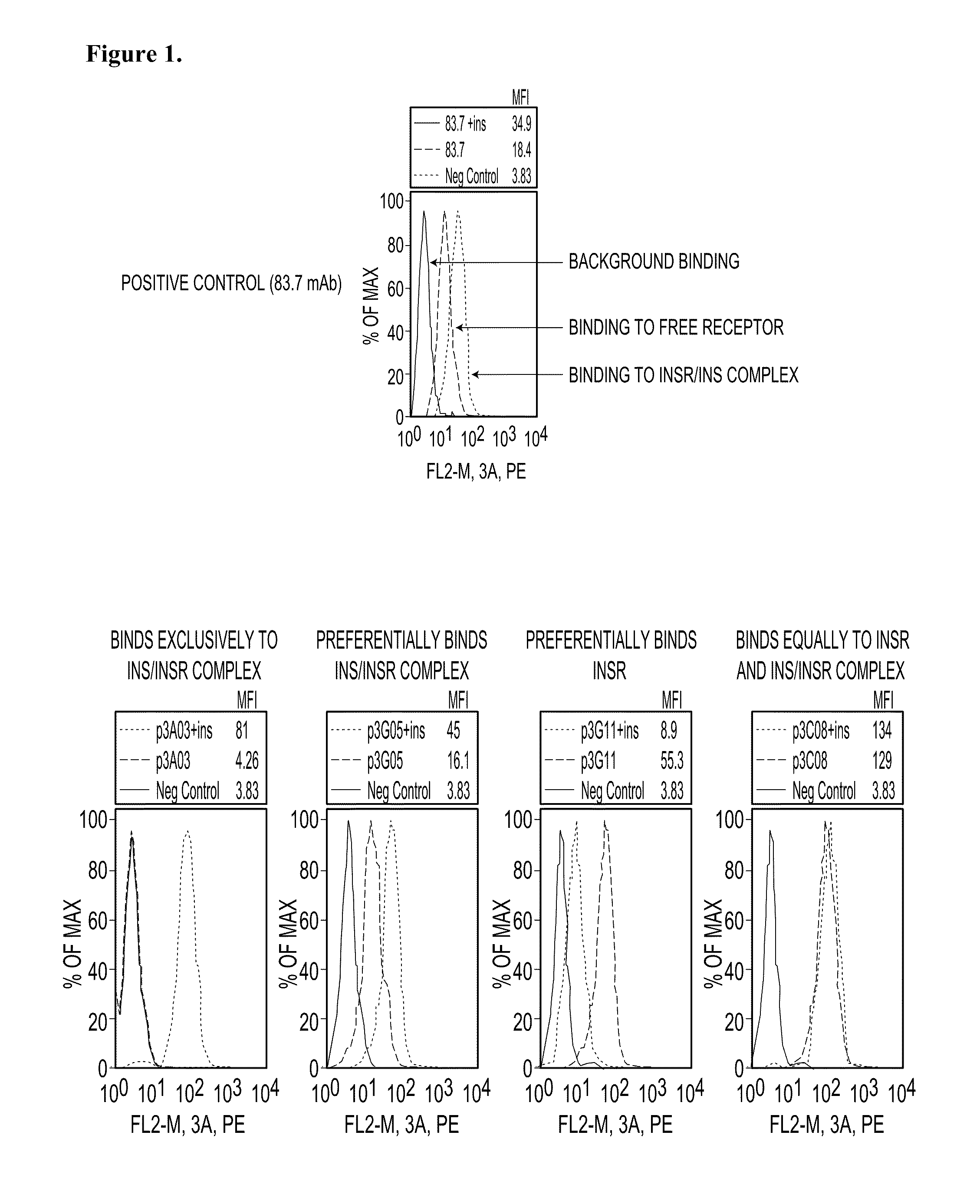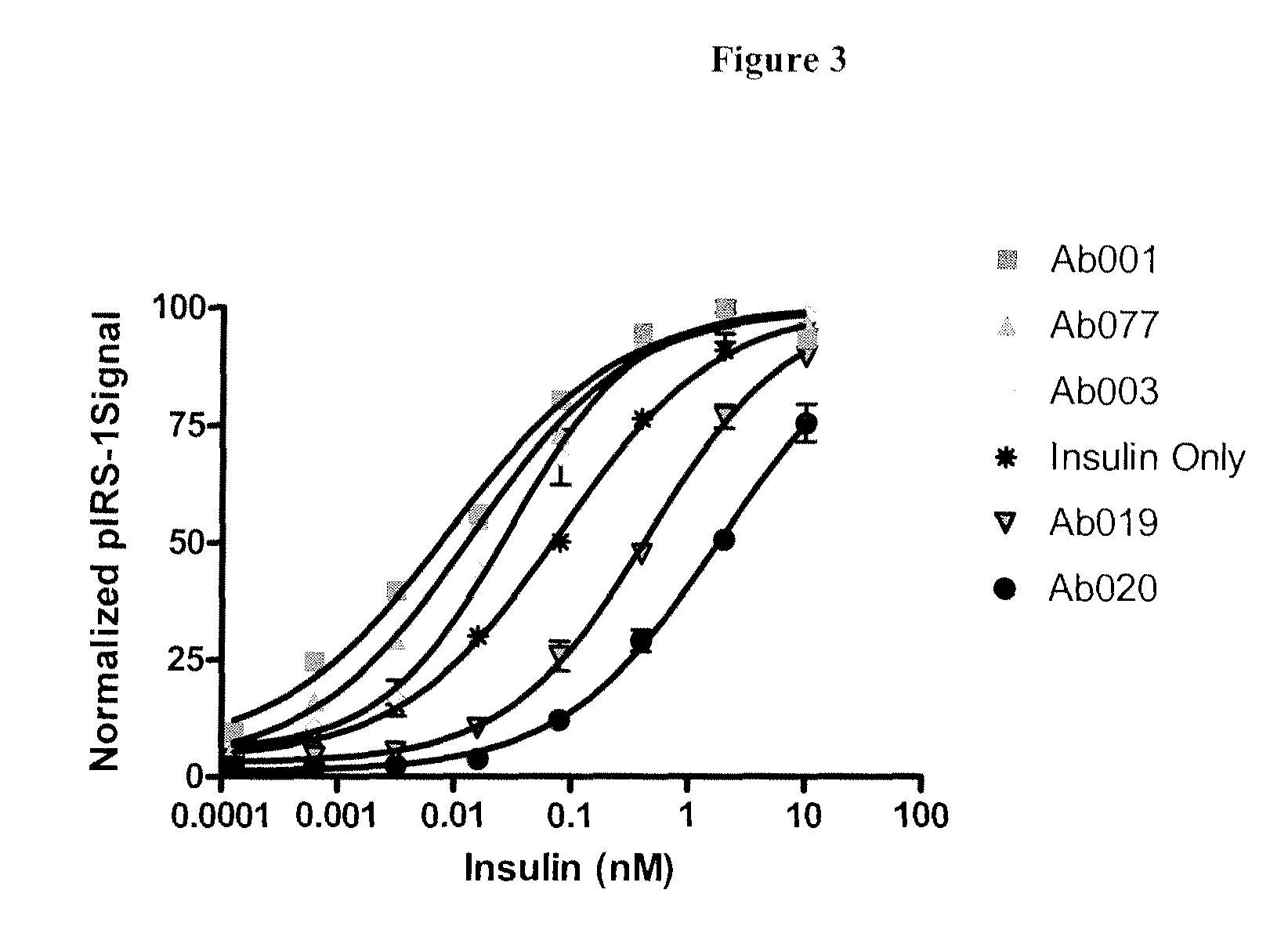Modulators
a technology of insulin and receptor, applied in the field of modulators, can solve the problems of high risk of complications, large percentage of type 2 diabetic subjects losing their response, and each approach has its limitations and adverse effects, so as to improve the impaired glucose tolerance of subjects, slow down, or normalize the weight gain of subjects
- Summary
- Abstract
- Description
- Claims
- Application Information
AI Technical Summary
Benefits of technology
Problems solved by technology
Method used
Image
Examples
example 1
Isolation of Anti-INSR Antibodies from Antibody Phage Display Libraries
(1) Phage Panning and Rescue
A. Naïve Antibody Phage Display Libraries
[0551]Human insulin receptor (hINSR) (R&D Systems, MN) was biotinylated with Sulfo-NHS-LC-Biotin (Pierce, Rockford, Ill.) using the manufacturer's protocol and 16-fold molar excess of biotin reagent. The biotinylation of hINSR was confirmed by surface plasmon resonance (SPR).
[0552]For the first round of phage panning, 1.6×1011 cfu of phage particles from an scFv phage display library (BioInvent, Lund, Sweden) were blocked for 1 h at room temperature (RT) in 1 ml of 5% milk / PBS (Teknova, Hollister, Calif.) with gentle rotation. Blocked phage were twice deselected for 30 minutes against streptavidin-coated magnetic Dynabeads® M-280 (Invitrogen Dynal AS, Oslo, Norway). To form the biotin-hINSR-hINS complex, 100 pmoles of biotinylated hINSR was preincubated with excess (2,100 pmoles) human insulin (hINS) (Sigma, Mo.) dissolved in 5% milk / PBS, for 1 ...
example 2
Receptor Occupancy Screen to Determine Antibody Binding to INSR in the Presence or Absence of Human Insulin
[0560]This example describes the use of flow cytometric (FACS) based assays to measure differential antibody binding to cells in the presence or absence of human insulin (hINS). Anti-insulin receptor (INSR) antibodies from phage display libraries were screened in the assays to identify modulators of INS-INSR binding.
[0561]IM-9 cells were obtained from the American Type Culture Collection (ATCC) and maintained in RPMI 1640+10% FBS. Prior to use in assays cells were washed in serum-free RPMI 1640, counted and the concentration adjusted to 2×106 cells / ml in RPMI 1640+0.5% BSA (Sigma-Aldrich). The cells were cultured overnight in this media and as such were designated as “serum-starved.” These cells were washed once and resuspended at 2×106 cells / ml in PBS containing 0.5% BSA and 0.01% sodium azide (FACS buffer).
[0562]Cells exposed to insulin were resuspended in FACS buffer supplem...
example 3
Biotinylated Ligand Screen to Determine the Effects of Anti-INSR Antibodies on Insulin Binding to INSR
[0569]This example describes the use of FACS based assays to measure differential ligand (human insulin) binding to cells in the presence or absence of anti-INSR antibodies. Anti-INSR antibodies from phage display libraries were screened in the assays to identify modulators of the INS-INSR complex.
[0570]IM 9 cells were obtained from the American Type Culture Collection (ATCC) and maintained in RPMI 1640+10% FBS. Prior to use in assays cells were washed in serum-free RPMI 1640, counted and the concentration adjusted to 2×106 cells / ml in RPMI 1640+0.5% BSA (Sigma-Aldrich). The cells were cultured overnight in this media and as such were designated as “serum-starved.” These cells were washed once and resuspended at 2×106 cells / ml in PBS containing 0.5% BSA (binding buffer).
[0571]Serum-starved cells were pre-exposed to INSR antibodies at room temperature for 15 minutes and then incubate...
PUM
 Login to View More
Login to View More Abstract
Description
Claims
Application Information
 Login to View More
Login to View More - R&D
- Intellectual Property
- Life Sciences
- Materials
- Tech Scout
- Unparalleled Data Quality
- Higher Quality Content
- 60% Fewer Hallucinations
Browse by: Latest US Patents, China's latest patents, Technical Efficacy Thesaurus, Application Domain, Technology Topic, Popular Technical Reports.
© 2025 PatSnap. All rights reserved.Legal|Privacy policy|Modern Slavery Act Transparency Statement|Sitemap|About US| Contact US: help@patsnap.com



